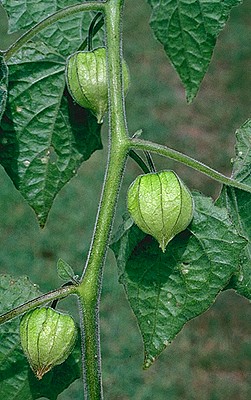
Synonymy
*Physalis peruviana L., Sp. Pl. 2nd edn 2: 1670 (1763)
T: "Habitat Limae. Alstroemer." From Lima, Peru; Lectotype : Herb. Linn. No. 247.7 (LINN) fide Heine in Aubréville & Leroy (ed.), Fl. Nouvelle-Calédonie 7 : 132 (1975). See The Linnaean Plant Name Typification Project pages on the Natural History Museum site.
A specimen bearing this name (microfiche number IDC 89.17) can also be seen in the Linnaean Herbarium in Stockholm (S) athttp://linnaeus.nrm.se/botany/fbo/p/physa/physper.html.en
Description
Short-lived shrub to 1 m, densely pubescent with glandular or simple, non-glandular hairs.
Leaves alternate, 2 per node (but not opposite); lamina ovate, cordate at base, up to 13 cm (usually c. 6 cm) long, entire or shallowly lobed; petiole to 5 cm long.
Pedicels 6–12 mm long. Calyx 7–10 mm long; lobes triangular-acuminate, 4–5 mm long. Corolla 5–angled, 10–15 mm long, dull yellow with distinct purple-brown spots alternating with the anthers. Anthers 4–5 mm long. Style 5–7 mm (occasionally to 11 mm) long. Fruiting calyx 10–angled, 27–40 mm long, the lobes free at apex for up to 10 mm, pale yellow-green to gold, drying to pale brown.
Berry globular, 10–20 mm diam., aromatic. Seeds disc-shaped, 1.7–2 mm long, pale yellow to orange-brown.
Distribution and ecology
Introduced to N.S.W. from the Cape of Good Hope at the end of 18th century. Robert Brown recorded Physalis pubescens in the Sydney region in 1802-4 (see Brown's list of introduced plants for the Sydney region reproduced in Journal of Botany 44: 234-5), but Brown's collection was re-determined by Symon (1981) as P. peruviana and has more recently been ascribed to P. angulata by Bean (2006).
Now a garden escape or weed of disturbed areas, occurring in Qld, N.S.W., Vic., Tas., S.A. and W.A.; commonest in south-eastern Australia; also on Lord Howe Is.
Common name
Cape gooseberry
Notes
An account of the fruit production of Cape Gooseberry may be found in: D. J. Klinac, Cape Gooseberry (Physalis peruviana) production systems. New Zealand J. Exp. Agric. 14: 425–430 (1986).
Derivation of epithet
peruviana - a reference to the place of collection of the type of the species.
Images and information on web
Information on this species in NSW can be seen on the PlantNet site at http://plantnet.rbgsyd.nsw.gov.au/cgi-bin/NSWfl.pl?page=nswfl&lvl=sp&name=Physalis~peruviana
Further information and links for P. peruviana can be found on the Plants for a Future site at www.ibiblio.org/pfaf/cgi-bin/arr_html?Physalis+peruviana&CAN=LATIND and other images can be found at Daves Garden site at http://davesgarden.com/pdb/go/1979/ and at www.tradewindsfruit.com/cape_gooseberry.htm
Information about the growing of P. peruviana as a fruit crop can be found at www.crfg.org/pubs/ff/cape-gooseberry.html
Information about P. peruviana as a weed in the Pacific can be seen at http://www.hear.org/pier/species/physalis_peruviana.htm together with mages.
Information about the possible toxic properties of Physalis species can be found with a search in the FDA Poisonous Plant Database
Note: with the confusion surrounding the application of names in Physalis, information given on the web which is species specific should be viewed with some caution.






